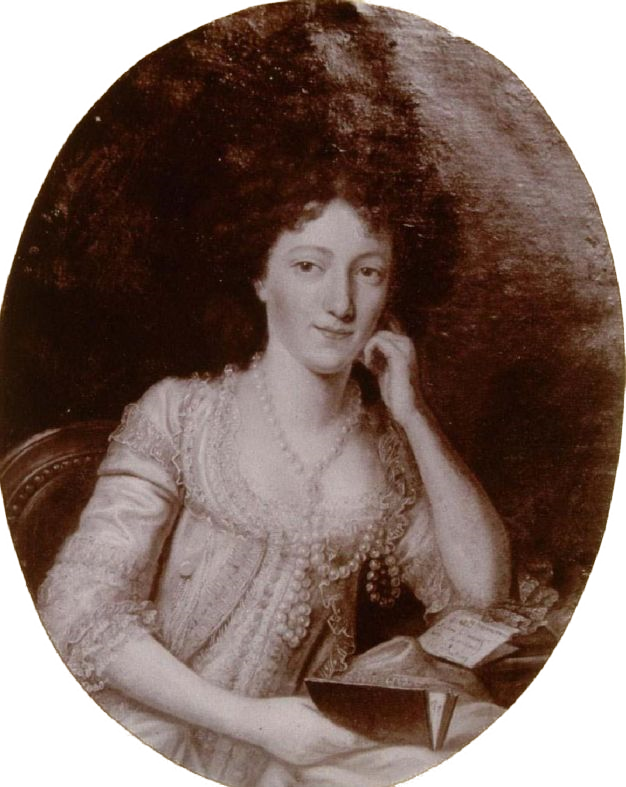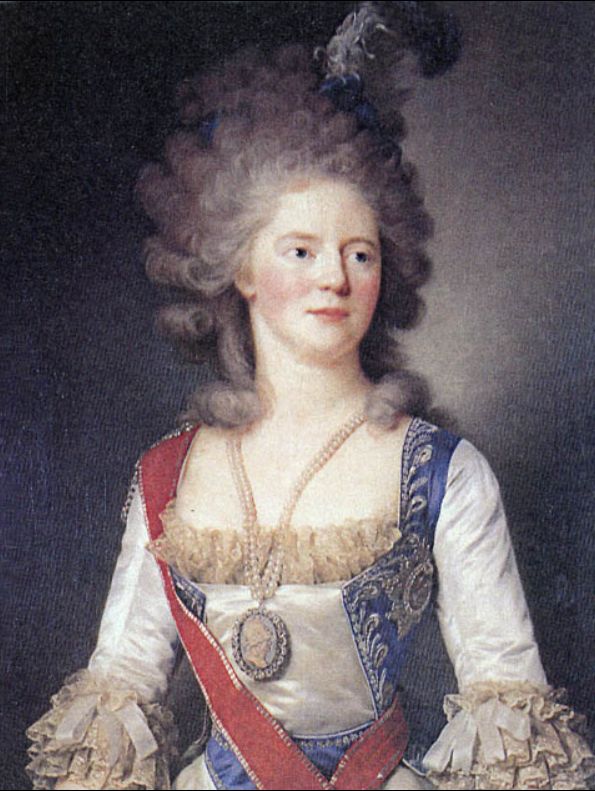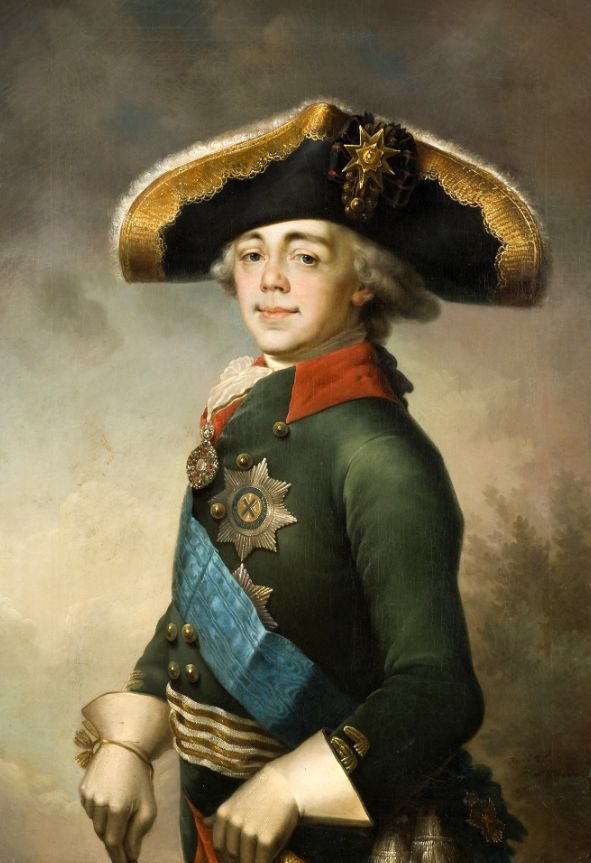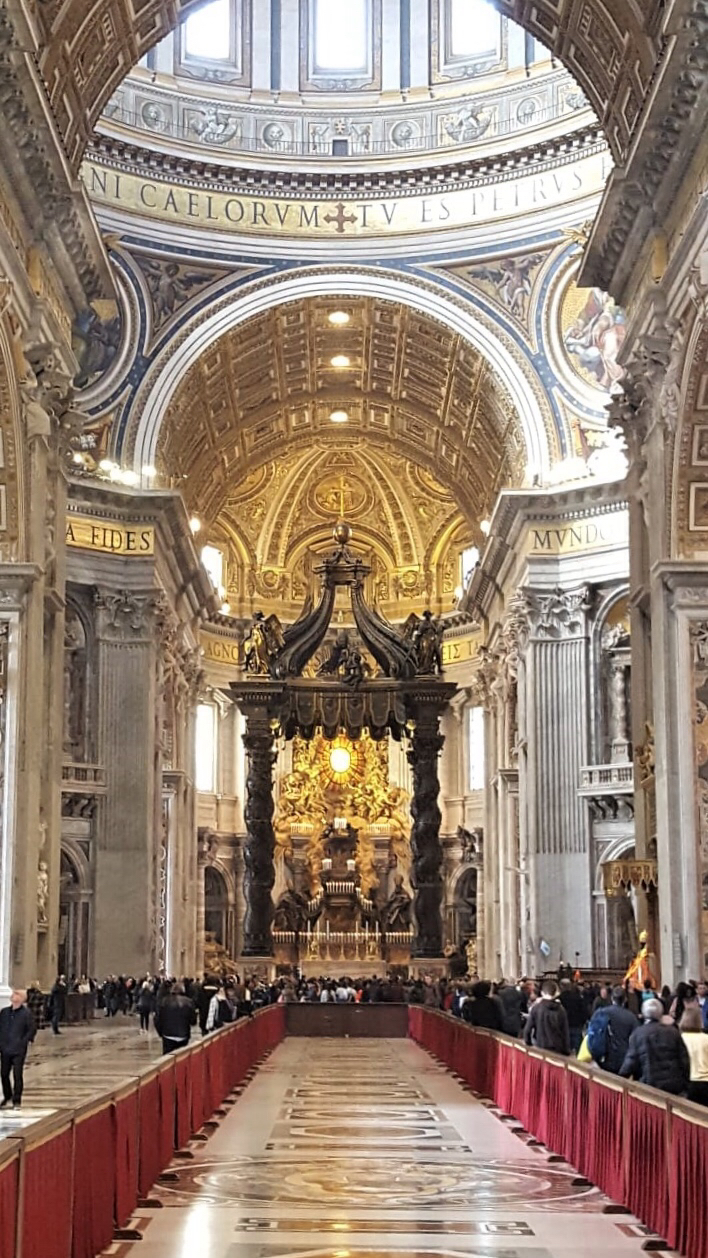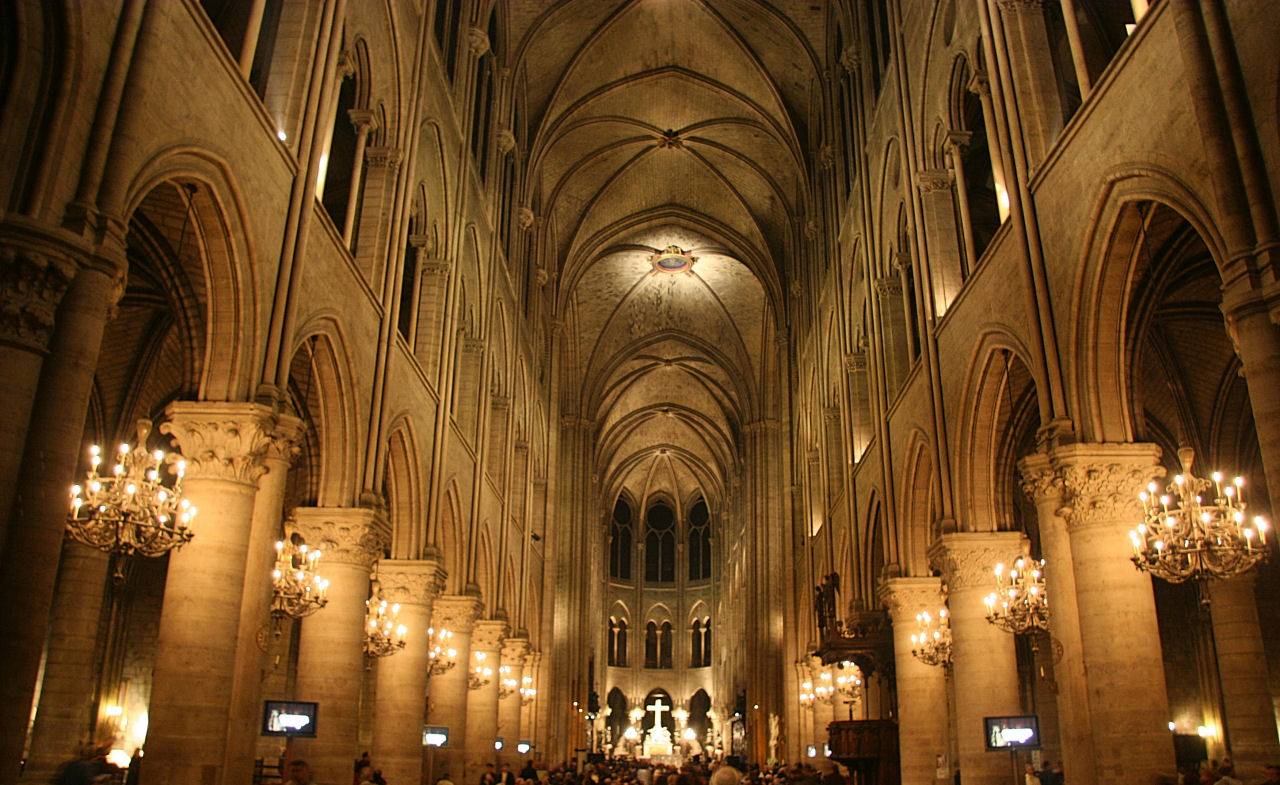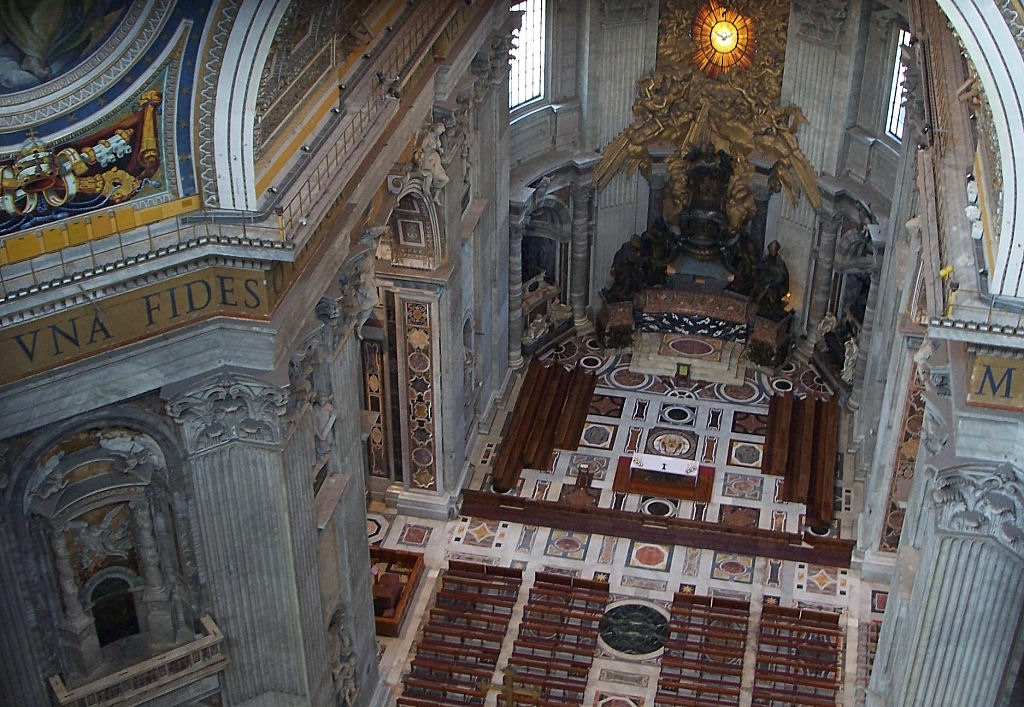|
Plinio Corrêa de Oliveira
The Baroness of Oberkirch: the beatiful of St. Peter’s Basilica and Notre Dame Cathedral
Santo do Dia, 18 de maio de 1976 |
|
|
Henriette Louise de Waldner de Freundstein, Baroness of Oberkirch (1754-1803) I have here something very interesting, an excerpt from the Memoirs of the Baroness of Oberkirch and the Contesse du Nord, 18th century, reign of Louis XV and Louis XVI. These are her comments and the Contesse du Nord’s, comparing St. Peter’s Basilica to Notre Dame Cathedral. It is a holy topic because it is a comparison between two Catholic churches and shows the reaction of a schismatic and a Protestant vis-a-vis two Catholic monuments. I believe that this deserves your atten-tion and to be dealt with at a Saint of the Day. Let me say a word about the Baroness of Oberkirch. I have read her memoirs a number of times and regret that I couldn’t read it anymore. It is a quintessence of the Ancien Régime, of the art of savoir faire, savoir rire, savoir plaire. It is a real marvel, the cream puff of civilization. A counter-revolutionary who has not read the Baroness of Oberkirch has not finished off his for-mation. If my [financial] situation was good, I would have a copy of the Memoirs of the Baroness of Ober-kirch offered to all TFP libraries. Even better if it were read in French. * “I would be unable to describe the orphanhood of a soul who cannot read French” If I could, I would have a French course set up for young people and others. I would like them to read French as their own mother tongue, without using a dictionary. I would be unable to describe the orphanhood of a soul who cannot read French. Teaching French to those who do not know it is one of the works of mercy. I myself am now nibbling three French books: “Funeral Prayers” by Bossuet, Servitude et grandeur militaire, by Alfred de Vigny, and Le Comte de Ségur. The French talent is pleasant, delicious, incomparable. Alfred de Vigny recounts that he came from a military family of the small nobility and was taught the military career for most of his life. He spent most of his military career in a period when France was at peace. It was the time of the fall of Napoleon, the Bourbons, and Louis Philippe. But he was always yearn-ing for war to play the hero. To describe his situation as a soldier who had memories of ancient wars in which his ancestors participated, and hopes to participate in new wars, he says, roughly, “I, who lived through the echos and dreams of wars, would have the same feeling if they gave me a handkerchief soaked in the most delicate perfume.” He speaks of a France that came to peace with the fall of Napoleon and the advent of Louis XVIII, a very peaceful man. He uses this expression: France, which put the sword into in the sheath of the Bourbons... The saying is highly fassur. I wanted to take the sheath of the Bourbons break it on the heads of Vigny and Napoleon. But the fact remains that it is a wonderful saying to indicate his disdain for Louis XVIII’s chubby pacifism. To say that he learned the glories of France from his father, mutilated by war, he writes, “I learned about war sitting on my father’s disabled knees.” This is just in passing. It is a paint, a color. You cannot compare those who read and understood it with those who read it and did not understand. One of my delights is to mine and extract emeralds and diamonds from this plot. Those unable to commonly and currently use the French language are missing all that. * The Baroness of Oberkirch was born in a region where German charm meets French charm Let’s go to our topic. Catherine the Great had a son who was Grand Duke and heir to the Russian throne. He married a princess of the House of Wittenberg of Germany—Saxe-Wittenberg, one of the great ducal Houses of Germany, which Napoleon later elevated to the category of a more or less false kingdom. But it is a great noble house connected to all the royal houses in Europe.
« Comtesse du Nord » (Sophie-Dorothée de Wurtemberg-Montbéliard, 1759-1828). Below: the Czar Paul I
The grand duke heir of Russia is going to tour Europe as all the important princes used to do at the end of the 18th century. That tour had become current in the 19th century because of the easy means locomotion – trains, steam ships, etc. Every prince—even if not a crown prince—toured every court in Europe to get to know them. But at his time, he was still doing it on horseback and it was much more difficult. To avoid very lengthy ceremonies of the protocol of the time—which, by the way, was not an attitude of good spirit on his part—he used the pseudonym Earl of the North. Although he traveled incognito, they naturally knew who he was and gave him, in private, all the honors befitting the heir to a throne, and, above all the powerful Russian throne. As her name implies, the Baroness of Oberkirch was a German lady–Oberkirch means “the church above” (up on the hill). She belonged to the Montbeliart branch of the Wittenberg family, from an area between Germany and France of which the landscapes are German but the charm is still French, forming a synthesis of the two things especially worthy of our attention to savor and delight over. * Nowadays, the best news comes from the past The Countess du Nord, a childhood companion, invited her to accompany them on the part of that trip. You can imagine if she accepted. As a maid of honor of the Countess du Nord, she met queens, princesses, all great characters with whom the Countess came into contact. She recounts charming scenes. For example, at that time, wearing eyeglasses was becom-ing common but was reputed to be very ugly – and it is – for ladies to wear glasses. So the ladies who had some visual defect began to wear glasses but veiled amid fans with feathers, raising the glasses to take a little distance and look. Marie Antoinette decided to give to the Comtesse du Nord among other gifts – because the ex-change of gifts was continuous – a pair of glasses in a fan, which was a novelty. Both were young and re-lated, but calling each other Madam. She said to the Comtesse du Nord: – Madam, I thought I noticed that, like me, you are shortsighted. And I thought that using this ob-ject might be attractive and advantageous for you. Would you please deign to try it? The Contesse du Nord immediately used the object and, turning to Marie Antoinette, said: – Madam, if it is to see you better, how can I not thank you? Isn’t this more interesting to know this than to hear about the latest massacred Brezhnev ordered or to whom he addressed his latest smirk? The other day someone said a great truth: “Nowadays, interesting news only comes from the past.” You are visibly interested in this news. It is news from the past. If I now said, “Let’s just forget about all this and make a political commentary about today,” I guarantee that you would be disappointed. * At St. Peter’s Basilica, man makes a pious effort to elevate himself to God. At Notre Dame Cathedral, God descends to men Let us finally go to the Baroness of Oberkirch’s comment.
“At St. Peter’s, says the Grand Duchess, one is crushed by the beauty, elevation and majesty of its nave. It seems that one dare not pray to the Almighty Being to whom men have raised such a high-class temple. In it, God appears too lofty and far away.
“At Notre Dame, on the contrary, the mystery and obscurity of stained glass, the centuries-old architecture which conveys the full power of religion, imparts recollec-tion and love. One has the hope of being listened to by God and the certainty of being heeded. One loves and hopes. At least, it is what I felt in both churches.” The Baroness of Oberkirch perfectly agrees. They really are two completely different churches. Notre Dame Cathedral is what you know, and so is St. Peter’s Basilica. Upon constructing the latter’s dom, Michelangelo took care to hide its size as much as possible. In my perspective as a 20th-century man – entirely different from 18th-century people – when I first saw St. Peter’s Basilica from the outside and entered it, I had a certain surprise thinking that it was much smaller than I had imagined. But that is because Sao Paulo’s apartments deteriorate my standards. However, when I was there, the tallest building in São Paulo was still Martinelli. I was told that St. Peter’s dome is so tall that the Martinelli building would fit inside it. You imagine how tall that is. There was a concern to disguise its height so that I– for whom Martinelli was a paradigm of height – found St. Peter’s dome low. At that time, when materialism had not yet made progress it has now made, it was beautiful to enhance proportion and hide size because size is matter and proportion is spirit. The spirit must dominate matter, as is entirely logical. However, St. Peter’s Basilica is all influenced by the Renaissance. Therefore, from an artistic point of view, it is an expression of the “wave” of classical beauty elements that spanned the 16th and 17th cen-turies up to the French Revolution and were presented by the generations that followed the Renaissance. It absolutely lacks the Catholic spirit of the Middle Ages. Arriving at St. Peter’s Basilica, one clearly sees that it is a composite church whose pomp is adequate for men to venerate the See of Peter, and in that sense, it is the first church in Christendom. But one way or another, in it, one does not have that feeling of closeness to God there one has in Notre Dame. Here is how I would translate this impression by the Countess du Nord: In St. Peter’s Basilica, I see an attempt by man to rise to God in a pious effort. In Notre Dame Cathedral, I see God descending to men. Because of that, closeness to God is much greater in Notre Dame than in St. Peter’s. For man, what is tall is not what rises above his stature but draws him near to God. This is the true height standard. And if God is closer to man in Notre Dame, then Notre Dame has more grandeur than a bigger church that he made like a ladder to try to ascend to God. It turns out that the Contesse du Nord was heir to a throne and had an obligation not to cause trouble with Catholics or the Holy See with her comments during the trip. So she only makes an indirect critique of St. Peter’s. You will appreciate here the diplomatic style of the time and understand that if Tal-leyrand is for us a giant comparable to no one, in the Ancien Régime, he was just a flower of an order of things that spread across Europe. * The Contesse du Nord’s diplomatic critique of St. Peter’s Basilica Let me show you the diplomatic side of her criticism, and you will see how delicately she ends up saying just that against St. Peter’s. She could not offend Catholics, and many of the Tsar’s subjects were Catholics, and she did not want to clash with them. There was still hope of conquering Poland, and if they presented themselves as opponents of the [Catholic] Religion, Poland would be much more resistant to any attempt at conquering it. All this together led her to display a lot of prudence and will see how prudently she phrased her idea.
“At St. Peter’s, says the Grand Duchess, one is crushed...” Now comes the compliment: “... by the beauty, elevation and majesty of its nave.” Now, by saying that the nave has a crushing beauty, she deftly ends up saying that the nave is crushing. She does it skillfully by employing ecrasée, crushed, to highlight that fact, and they swallow it. It seems that one dare not pray to the Almighty Being to whom men have raised such a high-class temple. I don’t know if you notice that deep down, she neatly hints at the idea of man’s ascent to God. Man has made a building so great and magnificent that it makes you afraid of God. It displays a tendency to ascend to God, but one that is frightening. She should have said God Our Lord. That “Almighty Being” smacks of “the great architect of the universe.” Now comes the proper praise a church is due. She ultimately says that St. Peter’s Basilica is a church as it should not be and that it does not facilitate prayer at all. It scares and crushes. But she says it in such a way that the first reading probably gave you a vague impression of it. You know that she praised the two churches and showed some perplexity. But when you look more closely, you feel that criticism was made by a supremely well-educated person who knows how to criticize. * The "savoir dire" of the Contesse du Nord. Charms of the Catholic tradition, when expressed in French Now comes the contrast with Notre Dame, praising Notre Dame and dressing down St. Peter’s: “At Notre Dame, on the contrary, the mystery and obscurity of stained glass, the cen-turies-old architecture which conveys the full power of religion...” In other words, Saint Peter was conceived in an epoch when religion had little power. It is a church little influenced by the religious spirit; instead, Notre Dame was built in centuries with an opposed men-tality, and its architecture is highly influenced by the religious spirit. As a temple, Notre Dame is worth a lot more. “... imparts recollection and love.” It is a perfect church. But note her “on the contrary.” Unlike St. Peter’s, Notre Dame imparts rec-ollection and love. What is St. Peter’s worth as a church, as a house of prayer? She says it so lightly that I think few would notice without this very patient analysis.
“In Notre Dame, on the contrary, one has the hope of being lis-tened to by God and the certainty of being heeded.” In Notre Dame, “on the contrary,” meaning that St. Peter’s has none of that. We are terrified. “... One loves and hopes. At least, it is what I felt in both churches.” That is, comparing the two churches. In other words, she criticized St. Peter’s Basilica and made a great compliment to Notre Dame Cathedral. But she took sides on such light, delicate, feminine and dip-lomatic terms that she did not commit any misstep. Savoir dire. Charms of the Catholic tradition when expressed the French language.. How different this is from the bishop who tried to attack us. Here you have two views and two mentalities. Would that poor fellow (to avoid saying that “miserable one”) not become furious if he heard this Saint of the Day? Why? Because it is about a Catholic order of values, and he is no longer Catholic. |
|

